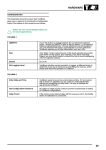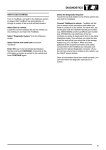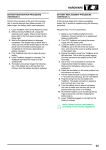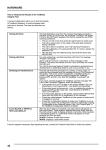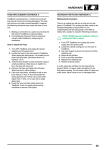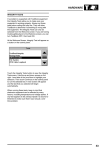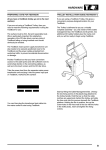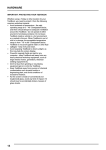Transcript
HARDWARE Vehicle Communication Serial Interface (VCSI) The vehicle communication serial interface (VCSI) allows TestBook to communicate with specified electronic control units (ECUs) and other devices that follow the ISO9141 standard. This international standard specifies the requirements for setting up the interchange of digital information between on-board ECUs of road vehicles and diagnostic testers. The ISO 9141 support consists of three main functional blocks: the asynchronous serial receiver/transmitter, counter/timers and the ISO 9141 physical interface. The asynchronous serial receiver/transmitter and counter/timer logic are implemented using a field programmable gate array (FPGA). The physical interface is electrically isolated from TestBook. TestBook VCSI can achieve a baud rate synchronization from 10 to 10K baud. TestBook is capable of operating, while not connected to a vehicle, for no more than 15 minutes based on a fully charged new battery. The system clock and configuration RAM on the system board in TestBook is battery backed up with a NiCAD (nickel-cadmium) battery. Mechanical Design TestBook is composed of two separate enclosures, a display unit and a base unit. The display unit houses the display, speaker and touch screen. The base unit houses all other electronics. The display unit is attached to the base unit through a pivot mechanism which allows it to be angled for normal use, folded down for transporting or removed for remote usage. The display unit is tethered to the base unit with one thin cable, allowing it to be easily moved around the vehicle. Base Unit Enclosure Power Sources TestBook can be connected directly across the vehicle battery terminals. In this mode of operation the VCSI and VOM isolations will keep the vehicle battery ground isolated from the signal ground. The isolated DC to DC converter will provide the ground isolation for the peripheral connectors such as the parallel and serial ports. The peripheral signals are not isolated. TestBook can also be powered from an external AC to DC power supply. This mode is especially useful to recharge TestBook internal battery while not in use. When connected to the vehicle TestBook uses DC power from the vehicle, with a voltage range of 9.7 V DC to 16V DC. If the vehicle power is lost or TestBook is disconnected from the vehicle, TestBook operates from its internal battery pack. The base unit enclosure consists of sheet metal parts that form a protective environment for the main electronics. The enclosure has rubber bumpers at strategic points to absorb shock from accidental drops. There is a handle at the top of the unit for transporting it. The display module has a storage location on the base unit. The display can be stored with the LCD facing the base unit. This configuration will protect the LCD during transportation. The display module can also be placed so the LCD faces away from the base unit to allow the user to interface with the tester without hand holding the display. Cables and Adapters The TestBook package contains the road test power supply. This cable has been designed to operate in the harsh automotive garage environment. The road test power supply connects TestBook to the vehicle battery. This cable is 4.2 metres long. It has red and black battery clamps at one end and a sub-miniature D power connector at the other. A black PVC molded fuse box is located near the clamp end. 7
